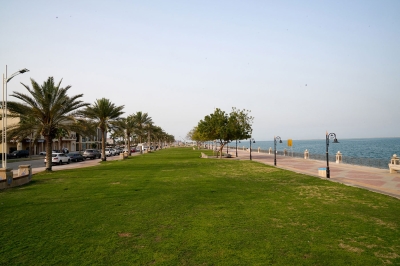




The Marine Nature of the Kingdom of Saudi Arabia comprises the features of its three coastal fronts on the two seas it borders: the Red Sea and the Arabian Gulf. The length of the Kingdom's coastlines is approximately 3,800 km. It has two coastal fronts on the Arabian Gulf to the east, extending 1,200 km, and a coastline along the Red Sea and the Gulf of Aqaba to the west, measuring around 2,600 km. This coastal nature has provided the Kingdom with economic, geographical, and geological significance, contributing to its natural diversity.
Marine nature of al-Uqayr Coast
Al-Uqayr Port is the first seaport in the east of the Kingdom, situated on the Arabian Gulf coast. It extends for forty-five km, from Ras Abu Ajl in the north to Tal al-Zeinat, and is about sixty-five km away from the Governorate of al-Ahsa. The port faces the southwestern tip of the Kingdom of Bahrain. Due to its shallow waters and their effect on water depth, ships do not currently dock there.
Historically, the port was known as the eastern maritime gateway for the people of al-Ahsa and Najd. It still preserves its archaeological landmarks, including the customs and passport building, the khan and market building, the fort, and the marine jetty. The port was once a destination for traders from the Arabian Peninsula, India, China, the Levant, Mesopotamia, Yemen, and African countries.
The King Abdulaziz Foundation for Research and Archives (Darah) has dedicated efforts to study and document this historic port, which witnessed the signing of agreements and political negotiations during the reign of the Founding King, Abdulaziz Bin Abdulrahman Al Saud. The port served as a venue for receiving delegations of Arab and foreign diplomats and was a site for political discussions and negotiations. The documentation has highlighted the port's political, economic, military, and even intellectual significance.
King Abdulaziz developed the port by establishing customs and passport offices, Abu Zahmol Tower, the Emara building, a water spring, and other facilities. The port became the primary supplier of goods and foodstuffs to the capital, Riyadh. Al-Uqayr is considered one of the most beautiful coasts in the Kingdom due to its diverse geographical features.
The waters of al-Uqayr contain islands and bays, including the significant islands of al-Futtaim and Zakhnouniyah. Today, it is a popular beach and tourist destination frequented by families and tourists. In 2018, it was recorded that more than twenty-eight thousand visitors per day came from various provinces of the Kingdom and Gulf Cooperation Council (GCC) countries.
Marine nature of the Red Sea
The Red Sea, located to the west of the Kingdom, is one of the seas with a large number of coral reefs and has a unique geological nature. It is also a significant maritime trade route, famously referred to by the French explorer Jacques Cousteau as "Mare Makkah" or "the Sea of Makkah," making it a popular destination for fishing and diving enthusiasts worldwide.
The Red Sea is classified as safe for coral reefs, and remains unaffected by global warming due to the purity of its ecosystems, which strengthens the chances of coral reef survival. Within Saudi Vision 2030, the Red Sea has experienced a tourism boom, becoming a prime destination for marine tourism.
The Red Sea is home to around fifty species of sharks, one thousand species of fish, and over three hundred types of coral reefs, some of which are as old as seven thousand years. It also contains a significant number of shipwrecks. Additionally, the Red Sea hosts the sailfish, which can reach speeds of up to 109 km/h, and the whale shark, which can grow up to twelve m in length.

The Kingdom has transformed Jeddah beach and corniche into an open-air museum as a part of a project to turn its beaches into artistic masterpieces. The museum features works by international artists. Efforts are underway to increase the green space along the waterfront by incorporating all existing squares into the corniche.
Related quizzes
Related articles

